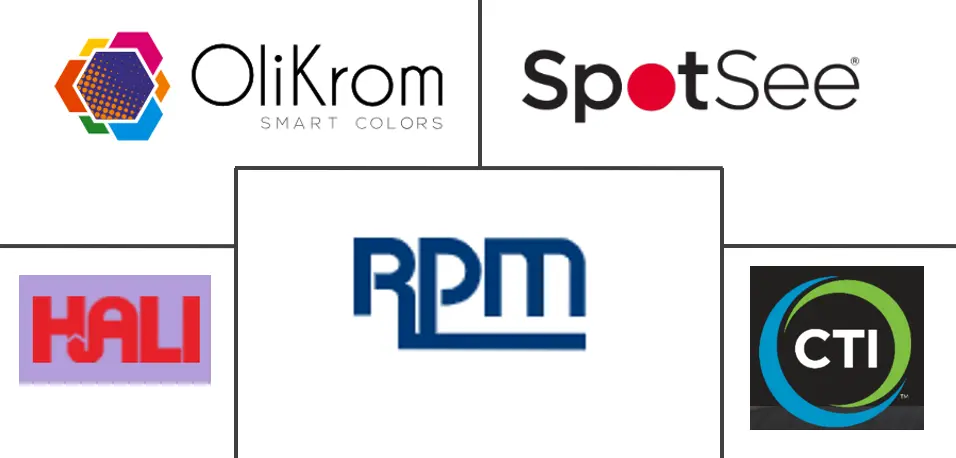Thermochromic Materials Market Size and Share

Thermochromic Materials Market Analysis by Mordor Intelligence
The Thermochromic Materials Market size is estimated at USD 2.64 billion in 2025, and is expected to reach USD 3.39 billion by 2030, at a CAGR of 5.15% during the forecast period (2025-2030). Rising compliance with cool-roof mandates, broader integration of printable smart labels, and swift gains in micro-encapsulation efficiencies collectively reinforce a steady demand curve. Reversible systems dominate both volume and value because they withstand thousands of thermal cycles, while leuco dye chemistry remains a favored option where cost sensitivity prevails. Asia-Pacific commands the largest regional position and delivers the fastest incremental growth as Chinese production capacity collocates with surging Indian consumption. Producers are simultaneously navigating cost premiums and durability constraints, prompting investments in formaldehyde-free shells and hybrid pigment systems that prolong outdoor lifetimes.
Key Report Takeaways
- By type, reversible systems held 63.34% of the thermochromic materials market share in 2024, while irreversible systems are forecast to post the highest 6.48% CAGR to 2030.
- By material, leuco dyes accounted for 44.15% share of the thermochromic materials market size in 2024; hybrid capsules are set to grow the quickest at 6.91% CAGR through 2030.
- By application, roof coatings led with 28.06% revenue share in 2024; the broader “other applications” basket, including battery sensing and wearables, is projected to advance at 7.04% CAGR by 2030.
- By end-user industry, building and construction dominated with a 35.29% share in 2024, whereas healthcare is expected to record the fastest 6.74% CAGR to 2030.
- By geography, Asia-Pacific captured 41.64% of global demand in 2024 and is on track for a 6.06% CAGR through 2030.
Global Thermochromic Materials Market Trends and Insights
Driver Impact Analysis
| Drivers | (~) % Impact on CAGR Forecast | Geographic Relevance | Impact Timeline |
|---|---|---|---|
| Cool-roof energy-saving mandates | +1.2% | North America, Europe, and expanding to APAC | Medium term (2-4 years) |
| Packaging anti-counterfeit regulations | +0.8% | Global, with emphasis on the EU and North America | Short term (≤ 2 years) |
| Printable smart-label adoption in retail | +0.6% | Global, led by developed markets | Medium term (2-4 years) |
| Rapid cost decline in micro-encapsulation | +0.9% | Global manufacturing centers in APAC | Long term (≥ 4 years) |
| Emerging demand from battery thermal sensing | +0.7% | APAC core, spill-over to North America and Europe | Long term (≥ 4 years) |
| Source: Mordor Intelligence | |||
Cool-roof Energy-saving Mandates Drive Market Expansion
Compliance measures such as California’s Title 24 move thermochromic materials from niche to mainstream building supplies. Dynamic pigments allow a single coating to switch from dark gray to white at 25 °C, generating 20% to 30% yearly HVAC savings in field trials. European and Asian regulators are drafting parallel roof standards that mirror the solar-reflectance and emissivity thresholds already codified in the United States, anchoring long-term demand for color-adaptive roof finishes that curb peak electricity loads and shrink carbon footprints.
Packaging Anti-counterfeit Regulations Accelerate Adoption
Globally harmonized rules for pharmaceutical and food security labeling are steering brands toward inks that reveal tampering or temperature abuse. Thermochromic features satisfy those mandates while meeting EU Regulation 1935/2004 limits on migratory substances[1]EUR-Lex, “Regulation (EC) No 1935/2004 on Materials and Articles Intended to Come into Contact with Food,” eur-lex.europa.eu. Higher product integrity combined with simplified authentication workflows justifies premium pricing, translating directly into added value for label converters facing cost pressures.
Printable Smart-label Adoption Transforms Retail Applications
Retailers have begun embedding touch-activated patches and cold-chain indicators onto everyday goods, turning packages into informational surfaces. UV-curable formulations that remain stable during flexographic runs now enable high-volume output without sacrificing adhesion. These interactive labels deepen shopper engagement and deliver instant quality validation, spurring repeat orders across beverages, meat, and dairy aisles.
Rapid Cost Decline in Micro-encapsulation Technology
Microfluidic encapsulation lines are hitting 99% efficiency, lowering waste while extending pigment lifetime by shielding leuco dyes from oxygen and moisture. Formaldehyde-free polyurethane-urea shells further comply with food-contact rules yet retain thermal stability, narrowing the historical 3 to 5 times cost gap with conventional pigments and broadening access for budget-constrained users.
Restraint Impact Analysis
| Restraints | (~) % Impact on CAGR Forecast | Geographic Relevance | Impact Timeline |
|---|---|---|---|
| High formulation cost versus conventional pigments | -1.1% | Global, particularly impacting price-sensitive markets | Short term (≤ 2 years) |
| Photo- and thermo-fatigue limiting lifetime | -0.8% | Global, especially outdoor applications | Medium term (2-4 years) |
| Restricted food-contact approvals in EU and US | -0.6% | Europe and North America, with regulatory spillover effects | Medium term (2-4 years) |
| Source: Mordor Intelligence | |||
High Formulation Cost Versus Conventional Pigments
A single kilogram of thermochromic powder can cost three to five times as much as a standard inorganic pigment, constraining usage in large-surface projects such as exterior façades. Process scaling and rising encapsulation yields are easing this premium, yet an upfront price hurdle endures for budget-driven buyers in emerging economies.
Photo and Thermo-fatigue Limiting Lifetime Performance
Ultraviolet exposure and repetitive heating cycles gradually break down molecular leuco dye structures, reducing switch contrast within months on south-facing façades. Research and development groups are testing hybrid shells infused with UV absorbers, but such upgrades make formulation complexity, and thus cost, even higher, tempering near-term volume growth for exterior paints.
Segment Analysis
By Type: Reversible Systems Sustain Market Leadership
Reversible systems contributed 63.34% of the thermochromic materials market in 2024 and continue to command attention because they endure thousands of switch cycles with minor chromatic drift. Such resilience underpins temperature labels for reusable containers and smart textiles that must react with every wear. Premium encapsulation films now shield leuco dyes from oxygen, retaining vivid hues beyond 10,000 heating-cooling rounds, a notable leap over prior generations.
Irreversible materials, although representing a smaller slice, are slated for 6.48% CAGR as brand owners adopt “once-only” color reveals for tamper evidence in pharmaceuticals and frozen-food logistics. Increased durability expectations motivate formulators to test bio-based shells and nano-additives that suppress fatigue without elevating cost. The thermochromic materials market benefits as reversible offerings migrate into consumer-oriented products such as mood-changing ceramics and interactive notebooks. Several appliance makers are also piloting reversible panels for stovetop safety cues, broadening application breadth and deepening volume potential.
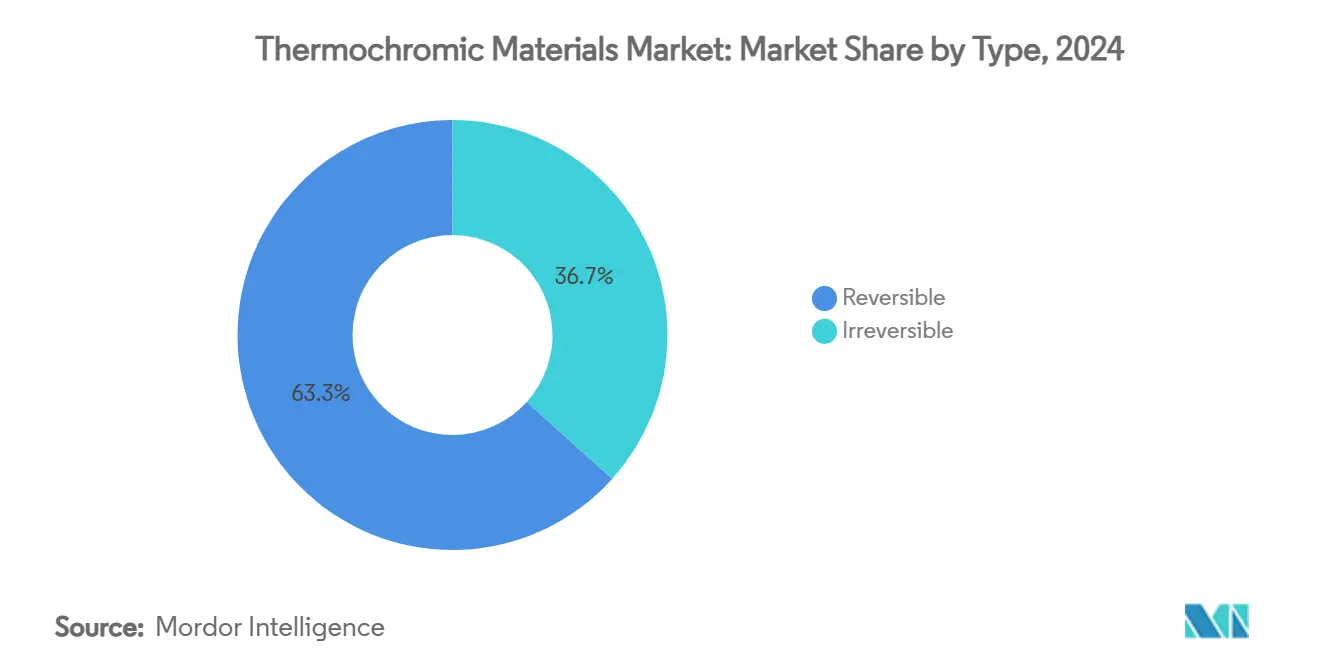
By Material: Leuco Dyes Maintain Dominance Through Cost-effectiveness
Leuco dye chemistry accounted for 44.15% of total demand in 2024, thanks to its mature supply chain and competitive unit pricing. Ongoing adoption of formaldehyde-free shell systems means leuco dyes now meet stringent contact and emission caps in Europe and North America while preserving color-transition sharpness. In turn, hybrid capsules blend leuco dyes with liquid crystals or photochromic molecules to extend the activation window, drawing a projected 6.91% CAGR to 2030.
Liquid crystals sustain a niche for high-precision thermography tools where 0.1 °C resolution is mandatory, yet their comparatively high price constrains mass-market penetration. Pigment-based inorganic solutions hold steady in ceramic glazes and plastics that need specific shade stability. Collectively, these material tiers empower formulators to select fit-for-purpose chemistries, supporting the thermochromic materials market’s breadth without compromising specialized performance.
By Application: Roof Coatings Lead Energy Efficiency Drive
Roof coatings delivered 28.06% of 2024 sales as regional building codes embraced dynamic reflectance metrics. Documented energy savings up to 11% annually continue to sway architects and facility managers toward thermochromic topcoats[2]Cool Roof Rating Council, “Test Methodologies for Solar Reflectance,” coolroofs.org. The thermochromic materials market size for roof coatings is expected to expand at a healthy clip as Title 24-type provisions proliferate beyond the United States.
A wider “other applications” category covering battery thermal mapping, wearables, and smart car interiors is set for a 7.04% CAGR. Interactive labels remain essential in security printing, whereas cosmetics firms deploy color-switch balms to enrich the user experience. These collective niches illustrate how the thermochromic materials market capitalizes on both functional and aesthetic triggers to maintain momentum.
By End-User Industry: Building and Construction Dominates Through Regulatory Support
Building and construction consumed 35.29% of the 2024 demand, making the sector the principal revenue anchor. Passive daytime radiative cooling layers that rely on thermochromic pigments lower indoor temperature peaks without mechanical systems, an attractive value driver for LEED and BREEAM builders. Although healthcare holds just a smaller base, it carries the swiftest 6.74% CAGR because fever-strip makers and wearable patch developers boost volumes.
Packaging players deploy heat-sensitive inks on drug blister packs and perishable foods, ensuring temperature compliance along multi-node supply lines. Consumer goods persist as a vibrant outlet, ranging from novelty toys to color-changing mugs, reinforcing end-user diversity that cushions the thermochromic materials industry from sector-specific swings.
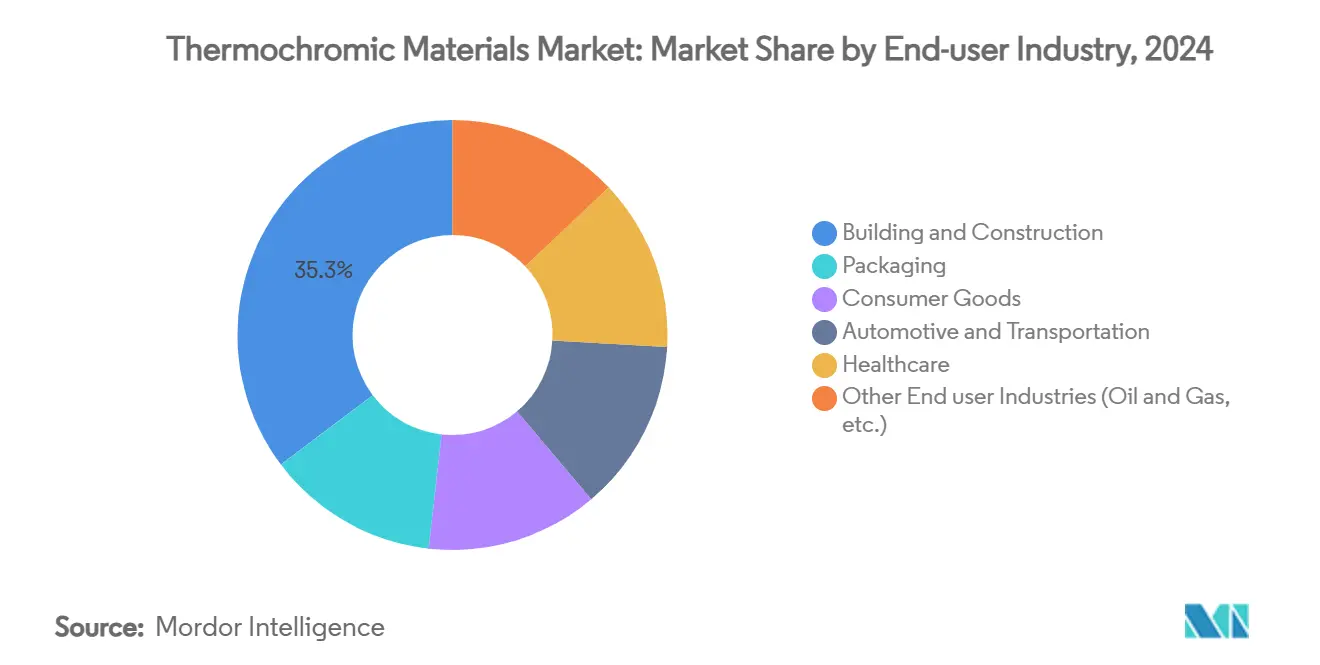
Note: Segment shares of all individual segments available upon report purchase
Geography Analysis
Asia-Pacific retained leadership with 41.64% share in 2024 as China supplied cost-effective bulk volumes and India adopted smart inks for pharmaceuticals and automotive interiors. The thermochromic materials market size in Asia-Pacific is forecast to advance at 6.06% CAGR to 2030, abetted by electric-vehicle battery sensing demand across regional gigafactories. Japan funnels research and development into liquid-crystal solutions that command premium prices for laboratory diagnostic kits, demonstrating that high-tech and mass-volume segments can coexist within one geography.
North America sustains demand momentum on the back of Title 24-like building codes, stringent food-safety labeling, and consumers who value interactive packaging. Domestic formulators continue to refine formaldehyde-free shells to meet forthcoming FDA guidance while preserving vivid color transitions. Europe follows close behind, driven by its Green Deal agenda and urban retrofits that integrate adaptive façade coatings, whereas Middle-East and Africa, and South America show incremental uptake as construction booms and retail chains scale cold-chain operations.
Collectively, regional dynamics underscore that the thermochromic materials market remains both supply-centered, owing to APAC cost advantages, and compliance-centered, owing to Western regulatory drivers. This duality enables cross-regional technology transfer yet sustains price differentials that shape buyer sourcing strategies.
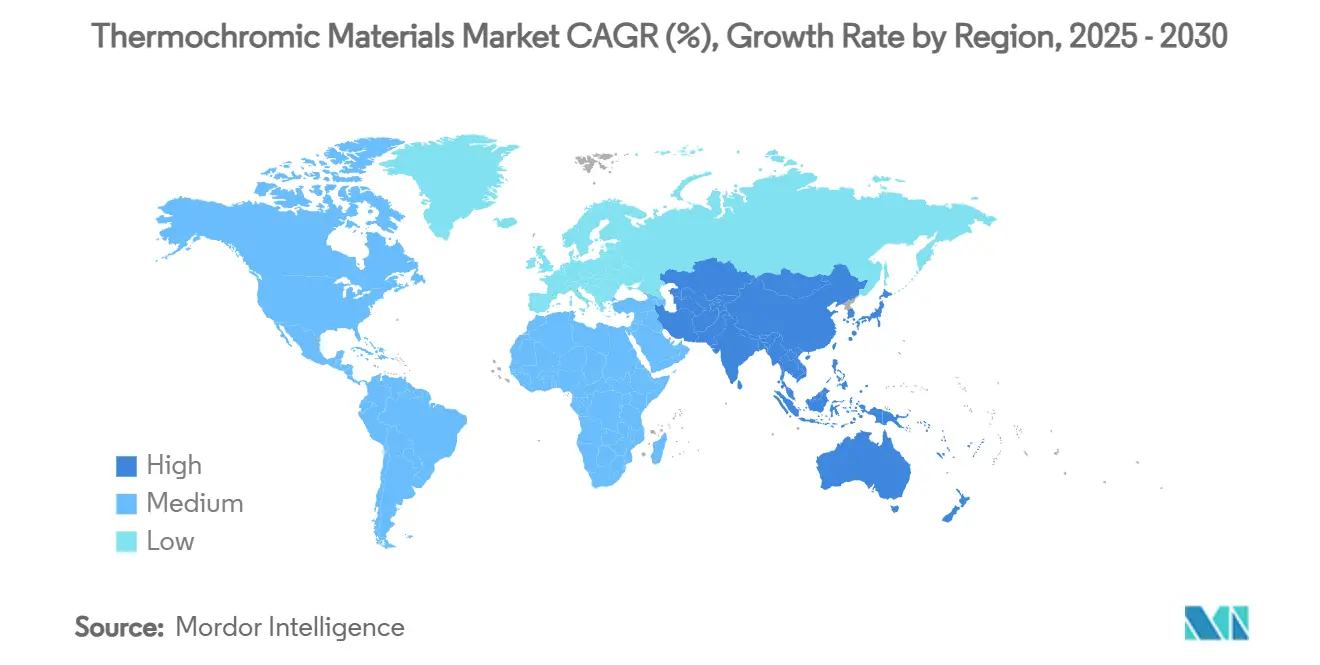
Competitive Landscape
The thermochromic materials market is moderately fragmented, with proprietary encapsulation skill sets acting as natural barriers to entry. Chromatic Technologies concentrates on fast-switch inks tailored for high-speed label presses, while Asian newcomers pursue scale efficiencies in leuco dye powders. Patent filings around microfluidic encapsulation and bio-based shells reveal intense research and development jockeying, signaling that intellectual property rather than brute volume will decide future leadership stakes. Strategic partnerships between pigment suppliers and smart-label converters are spreading risk and accelerating time-to-market for niche applications like battery heat maps and medical patches.
Thermochromic Materials Industry Leaders
-
Chromatic Technologies Inc.
-
Hali Pigment Co. Ltd
-
SpotSee
-
OliKrom
-
RPM International Inc. (Rust-Oleum)
- *Disclaimer: Major Players sorted in no particular order
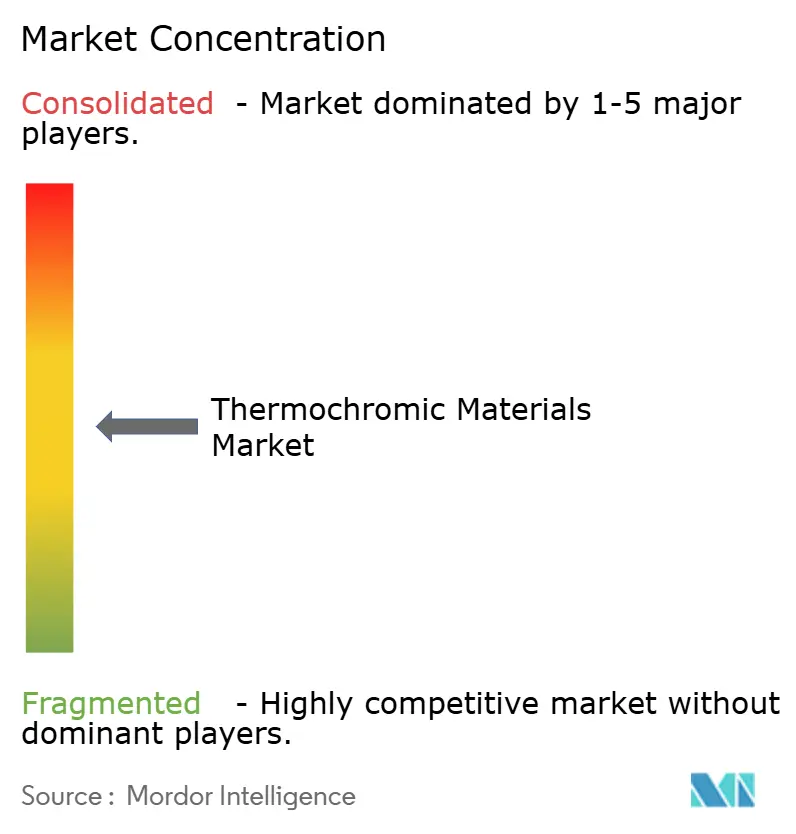
Recent Industry Developments
- July 2024: Merck KGaA finalized the divestiture of its Surface Solutions unit, including thermochromic pigment solutions, to Global New Material International for USD 721 million.
- June 2024: European Coatings reported new research detailing formulation tweaks that enhance thermochromic pigment durability in organic roof coatings.
Global Thermochromic Materials Market Report Scope
The thermochromic material market report includes:
| Reversible |
| Irreversible |
| Liquid Crystal |
| Leuco Dyes |
| Pigments |
| Other Materials (Hybrid Capsules, etc.) |
| Roof Coatings |
| Printing |
| Food Packaging |
| Cosmetics |
| Other Applications (Textiles and Fashion, etc.) |
| Building and Construction |
| Packaging |
| Consumer Goods |
| Automotive and Transportation |
| Healthcare |
| Other End user Industries (Oil and Gas, etc.) |
| Asia Pacific | China |
| India | |
| Japan | |
| South Korea | |
| Rest of Asia Pacific | |
| North America | United States |
| Canada | |
| Mexico | |
| Europe | Germany |
| France | |
| United Kingdom | |
| Italy | |
| Rest of Europe | |
| South America | Brazil |
| Argentina | |
| Rest of South America | |
| Middle-East and Africa | Saudi Arabia |
| South Africa | |
| Rest of Middle-East and Africa |
| By Type | Reversible | |
| Irreversible | ||
| By Material | Liquid Crystal | |
| Leuco Dyes | ||
| Pigments | ||
| Other Materials (Hybrid Capsules, etc.) | ||
| By Application | Roof Coatings | |
| Printing | ||
| Food Packaging | ||
| Cosmetics | ||
| Other Applications (Textiles and Fashion, etc.) | ||
| By End-User Industry | Building and Construction | |
| Packaging | ||
| Consumer Goods | ||
| Automotive and Transportation | ||
| Healthcare | ||
| Other End user Industries (Oil and Gas, etc.) | ||
| By Geography | Asia Pacific | China |
| India | ||
| Japan | ||
| South Korea | ||
| Rest of Asia Pacific | ||
| North America | United States | |
| Canada | ||
| Mexico | ||
| Europe | Germany | |
| France | ||
| United Kingdom | ||
| Italy | ||
| Rest of Europe | ||
| South America | Brazil | |
| Argentina | ||
| Rest of South America | ||
| Middle-East and Africa | Saudi Arabia | |
| South Africa | ||
| Rest of Middle-East and Africa | ||
Key Questions Answered in the Report
What is the current size of the thermochromic materials market?
Thermochromic materials market size hit USD 2.64 billion in 2025 and is projected to reach USD 3.39 billion by 2030.
Which region leads the thermochromic materials market?
Asia-Pacific holds the largest 41.64% share and is also the fastest-growing region at 6.06% CAGR through 2030.
Why are reversible thermochromic systems so prevalent?
They account for 63.34% market share because they endure thousands of color cycles, fitting reusable labels, textiles, and interactive packaging.
What is driving thermochromic adoption in construction?
Cool-roof mandates such as California’s Title 24 require dynamic heat-management coatings, making thermochromic roof layers a compliance solution that can cut annual cooling loads by up to 30%.
Which end-user industry shows the fastest growth?
Healthcare applications, including wearable fever sensors, are advancing at 6.74% CAGR due to rising demand for real-time, non-invasive patient monitoring.
Page last updated on:
